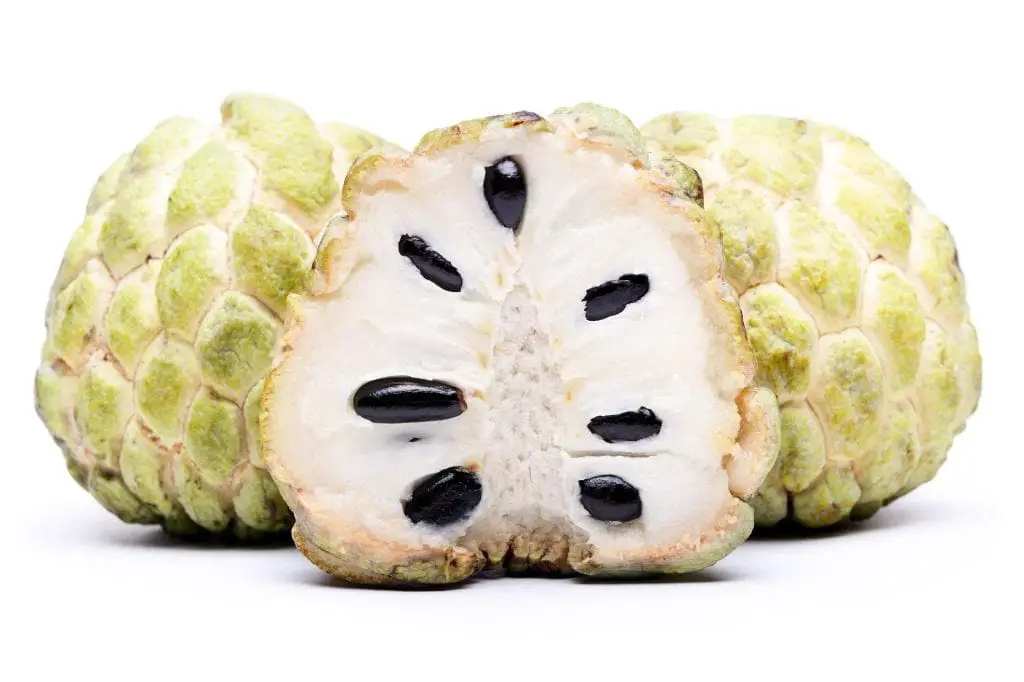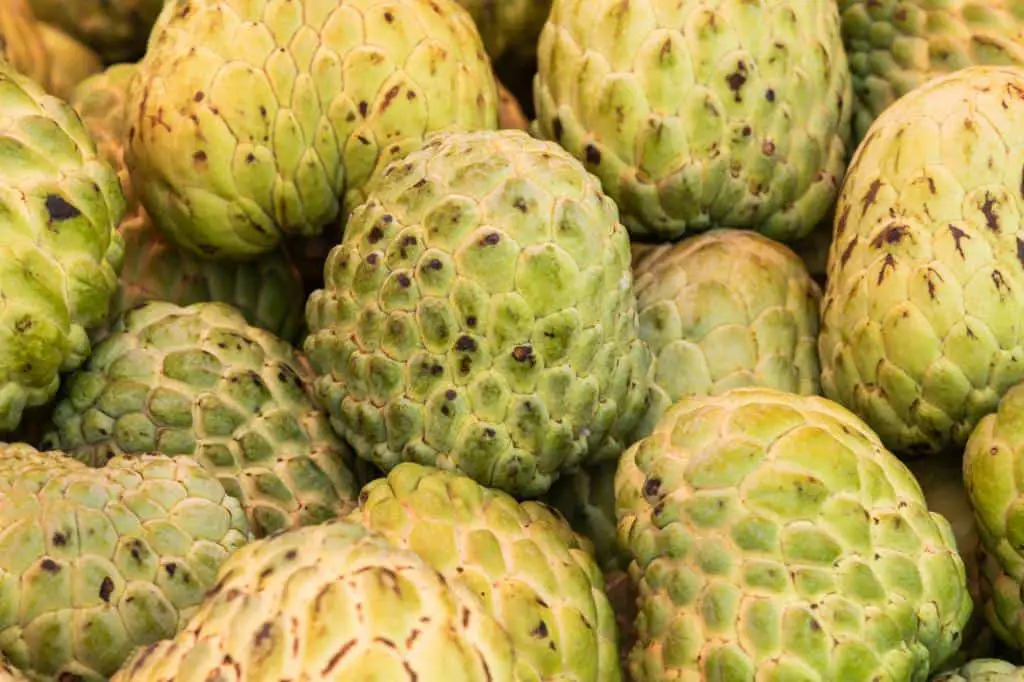Can You Eat Cherimoya Skin? Is Cherimoya Peel Edible and Safe to Eat?

Delve into the world of cherimoya, where flavor meets curiosity, and the question of whether to indulge in its skin adds a tantalizing twist. The lush, green exterior of this exotic fruit hints at the treasure it holds within—a creamy, delectable flesh that’s both sweet and tangy. But as you ponder its peel, a natural curiosity arises: Can you eat cherimoya skin? Is this vibrant shell edible and safe to enjoy?
Most people discard the skin and the seeds and only eat the pulp of cherimoya, which should not be crushed.
In a culinary landscape that often emphasizes the inner delights of fruits, exploring the edibility of a fruit’s outer layer introduces a new dimension to savoring flavors.
Cherimoya, beckons with its velvety texture and enchanting taste, leaving us to wonder whether its skin is a hidden gem waiting to be savored.
Join us as we journey through the vibrant realms of cherimoya, uncovering the secrets of its peel, and ultimately, discovering whether the essence of this captivating fruit extends beyond its luscious core.
The Cherimoya: A Tropical Delight
Before we delve into the skin, let’s take a moment to appreciate the cherimoya itself. Often referred to as “custard apple” due to its creamy consistency, the cherimoya boasts a unique taste that’s a delightful blend of various flavors. Imagine notes of banana, pineapple, and even a hint of citrus, all wrapped up in one fruit.
Cherimoya is known for its green, scaly exterior, which holds within it a treasure trove of creamy flesh and shiny black seeds. But what about the outer layer that protects this sweet goodness?
The cherimoya fruit is a large, green, conical, or heart-shaped compound fruit. Here are some key details about the cherimoya fruit:
- Appearance: The cherimoya fruit is typically 10–20 cm (3.9–7.9 in) long, with diameters of 5–10 cm (2.0–3.9 in). It has a green skin that gives the appearance of having overlapping scales or knobby warts. As it ripens, the skin turns brown with a fissured surface.
- Weight: On average, cherimoya fruits weigh between 150 and 500 g (5.3 and 17.6 oz), but extra-large specimens can weigh 2.7 kg (6.0 lb) or more.
- Flavor: The flavor of cherimoya is often described as a blend of pineapple and pear, with notes of mango, strawberries, and lemon. It has a strong, sweet taste that some people find reminiscent of custard.
- Ripening: Cherimoya fruits can ripen in about five days if kept at 15 to 20 °C (59 to 68 °F).
Nutritional Benefits: Cherimoya is rich in nutrients and offers various health benefits. It contains lutein, a carotenoid related to vitamin A and beta-carotene, and is a good source of dietary fiber, vitamin C, and potassium.
It’s important to note that the seeds and skin of the cherimoya fruit contain a neurotoxin called annonacin and should not be eaten
Many Ways to Enjoy Cherimoya Fruit
Indulging in the delightful flavors of cherimoya offers a world of culinary possibilities. This exotic fruit, often referred to as the “custard apple,” captivates with its creamy texture and sweet-tart taste. Discover the many ways to enjoy cherimoya, from simple and refreshing to creatively gourmet.
1. Fresh and Unadorned: Sometimes, the best way to appreciate a fruit’s essence is by savoring it fresh and unadorned. Simply cut the cherimoya in half, scoop out the luscious flesh with a spoon, and enjoy the natural flavors that are a testament to the fruit’s tropical origin.
2. Smoothies and Shakes: Elevate your breakfast routine by adding cherimoya to your morning smoothies or shakes. Blend it with other fruits like banana and berries, along with a splash of yogurt or your preferred milk, for a creamy and nutritious concoction.
3. Exquisite Desserts: Cherimoya’s custard-like consistency makes it an ideal ingredient for a range of desserts. Whip up a cherimoya pudding by blending the fruit with a touch of honey and a dash of vanilla extract. Or explore its potential in tarts, parfaits, and fruit salads for an exquisite and refreshing treat.
4. Culinary Creativity: Cherimoya’s unique flavor profile also lends itself to savory dishes. Incorporate it into salsas or chutneys to accompany grilled meats, or add it to salads for a surprising burst of tropical goodness.
5. Frozen Delights: Freeze cherimoya pulp in ice cube trays for a quick addition to your beverages, keeping them cool and flavorful without diluting the taste.
From its raw, unembellished form to the heartiest culinary creations, cherimoya invites you to a gastronomic adventure filled with delectable experiments. So, the next time you encounter this velvety fruit, let your taste buds roam freely as you explore the numerous ways to relish the essence of cherimoya.
How To Select a Ripe Cherimoya Fruit

To select a ripe cherimoya fruit, you can follow these tips:
- Check the color: A ripe cherimoya fruit will have a brownish-green skin that is slightly soft to the touch.
- Squeeze gently: When you gently squeeze the fruit, it should give slightly, like a ripe peach.
- Avoid bruises: Cherimoya fruits bruise easily, so look for fruits that are free of bruises or soft spots.
- Smell it: A ripe cherimoya fruit will have a sweet, fruity aroma.
- Look for the fallen fuss: If you are picking cherimoya fruits from a tree, check if the fuss falls off, which is a sign that the fruit is ripe.
- Wait for it: If the cherimoya fruit is not yet ripe, you can ripen it at room temperature for about a week.
Once you have selected a ripe cherimoya fruit, you can enjoy it chilled and raw, or use it in various recipes such as compotes, ice creams, sorbets, cocktails, smoothies, and more
The Cherimoya Skin: Edible or Not?
The cherimoya skin is not recommended to be eaten. However, some may find it quite challenging to eat its skin. It’s important to approach it with a few considerations in mind.
The skin has a slightly bumpy texture, and its taste is notably more bitter compared to the velvety sweetness of the fruit’s interior. Some people might find the taste of the skin to be an acquired preference, while others might opt to remove it due to personal preference.
Pros of Eating Cherimoya Skin:
- Nutrient Density: The skin, like many fruit peels, contains a good amount of nutrients such as dietary fiber, vitamins, and antioxidants.
- Reducing Waste: By eating the skin, you contribute to minimizing food waste, making your culinary experience more sustainable.
- Texture Variation: The skin adds a contrasting texture to the creamy flesh, providing an interesting sensory experience.
Cons of Eating Cherimoya Skin:
- Bitterness: The skin’s bitterness might not be palatable for everyone, and it could overpower the delicate sweetness of the flesh.
- Pesticide Concerns: If not organically grown, the skin might have traces of pesticides. Ensure proper washing or opt for organic cherimoyas when planning to consume the skin.
Safety Precautions and Preparation
If you’re tempted to give cherimoya skin a try, it’s essential to follow some safety precautions and proper preparation steps:
- Thorough Washing: Regardless of whether you plan to eat the skin or not, always wash the cherimoya under running water to remove dirt, bacteria, and any potential pesticide residue.
- Organic vs. Non-Organic: If you’re concerned about pesticides, opt for organic cherimoyas. Organic produce tends to have fewer pesticide residues, making the skin safer to eat.
- Personal Taste: As with many culinary choices, personal taste plays a significant role. If you’re open to new flavors and enjoy bitter undertones, you might find the skin’s taste intriguing.
- Culinary Creativity: If you decide to eat the cherimoya skin, consider ways to incorporate it into your culinary creations. You could blend it into smoothies, chop it finely for salads, or even candy it for a unique dessert topping.
Serving Suggestions and Culinary Adventures
Eating cherimoya skin opens the door to exciting culinary experiments. Here are a few creative ways to enjoy the skin alongside the flesh:
| 1. Cherimoya Salsa: | Create a refreshing salsa using diced cherimoya skin, diced flesh, red onion, cilantro, lime juice, and a touch of jalapeno for a hint of heat. Serve it with grilled fish or as a topping for tacos. |
| 2. Skin-infused Water: | Add thin slices of cherimoya skin to your water for a subtly flavored and visually appealing hydration option. It’s a great alternative to plain water. |
| 3. Candied Cherimoya Peel: | If you have a sweet tooth, try candying the skin. Simmer it in a simple syrup until tender, then coat it in sugar for a delectable treat. |
| 4. Skin Garnish: | Use thin strips of cherimoya skin as a garnish for desserts like custards, ice creams, and tarts. It adds an artistic touch and a hint of flavor. |
Common Cherimoya Skin Misconceptions and Myths
Misconceptions, much like shadows, tend to obscure truths. A common misconception regarding cherimoya peel is its outright inedibility due to perceived toxicity. However, science offers a more nuanced perspective. The presence of annonacin, while needing careful consideration, doesn’t automatically render the peel unsafe. Debunking this myth unravels the world of culinary possibility that cherimoya peel holds.
Another myth ties into the perceived health risks or benefits of cherimoya peel consumption. As with many foods, sweeping declarations can be misleading. Cherimoya peel isn’t a magical elixir or a sinister potion. The truth lies in balance and measured exploration. It’s a journey to understanding cherimoya peel’s place within the intricate tapestry of your diet.
Practical Tips and Recommendations
For those with a penchant for culinary exploration, cherimoya peel offers a realm of potential. To embark on this journey, consider a few practical tips. Firstly, moderation is the keystone. Cherimoya peel, when consumed judiciously, can contribute positively. Secondly, portion control is vital. Integrating the peel into your diet need not involve devouring entire peels – a delicate touch is often more rewarding.
Individuality shines through in considerations of allergies and sensitivities. Just as you would with any new food, approach cherimoya peel thoughtfully. If you have known allergies or sensitivities, it’s wise to tread with caution. Always listen to your body’s signals.
In Conclusion
Is it okay to eat cherimoya skin? The answer is yes, but with a few important considerations. The edibility of cherimoya peel opens up a realm of culinary exploration. The skin, while safe to consume, comes with a slightly bitter taste that might not suit everyone’s palate. However, for the adventurous epicure, this intriguing bitterness can be embraced as a unique flavor profile.
Cherimoya skin nutrition is an aspect that adds to its allure. Rich in nutrients, the peel offers health benefits that complement its distinct taste. It contains dietary fiber, vitamins, and antioxidants that contribute to overall well-being. To make the most of these advantages, remember to wash the fruit thoroughly before consumption, and opting for organic varieties can further enhance the cherimoya skin’s safety.
Cherimoya skin’s culinary uses go beyond mere consumption. It can be creatively utilized in culinary endeavors, offering a surprising twist to dishes. From infused waters to homemade jams, the peel’s bitterness can add depth to recipes that play with contrasting flavors. Whether you’re devouring the entire fruit or relishing its creamy interior, cherimoya stands as a tropical marvel, ready to tantalize your taste buds and contribute its nutrient content to your wellness journey.
FAQs on Consuming Cherimoya Skin
Is cherimoya skin toxic?
No, cherimoya skin is not toxic. It’s edible but has a slightly bitter taste that might not be palatable for everyone.
How do you eat cherimoya properly?
Cut it in half and scoop out the creamy flesh. Avoid the seeds, as they’re not edible. Some eat the skin, but it’s a matter of personal preference.
What does cherimoya taste like?
Cherimoya’s taste is a mix of banana, pineapple, and citrus notes, creating a unique tropical flavor.
Can you use cherimoya peel in cooking?
Yes, you can use cherimoya peel in cooking. It adds a contrasting texture and flavor to dishes.
Are there any health benefits to eating cherimoya skin?
Yes, you can use cherimoya peel in cooking. It adds a contrasting texture and flavor to dishes.
What precautions should I take when consuming cherimoya peel?
Wash the fruit thoroughly to remove dirt and potential pesticides. Opt for organic cherimoyas if you are concerned about pesticides.
Are there any allergic reactions associated with cherimoya skin?
Allergic reactions to cherimoya skin are rare but possible. If you have known allergies, approach with caution.






